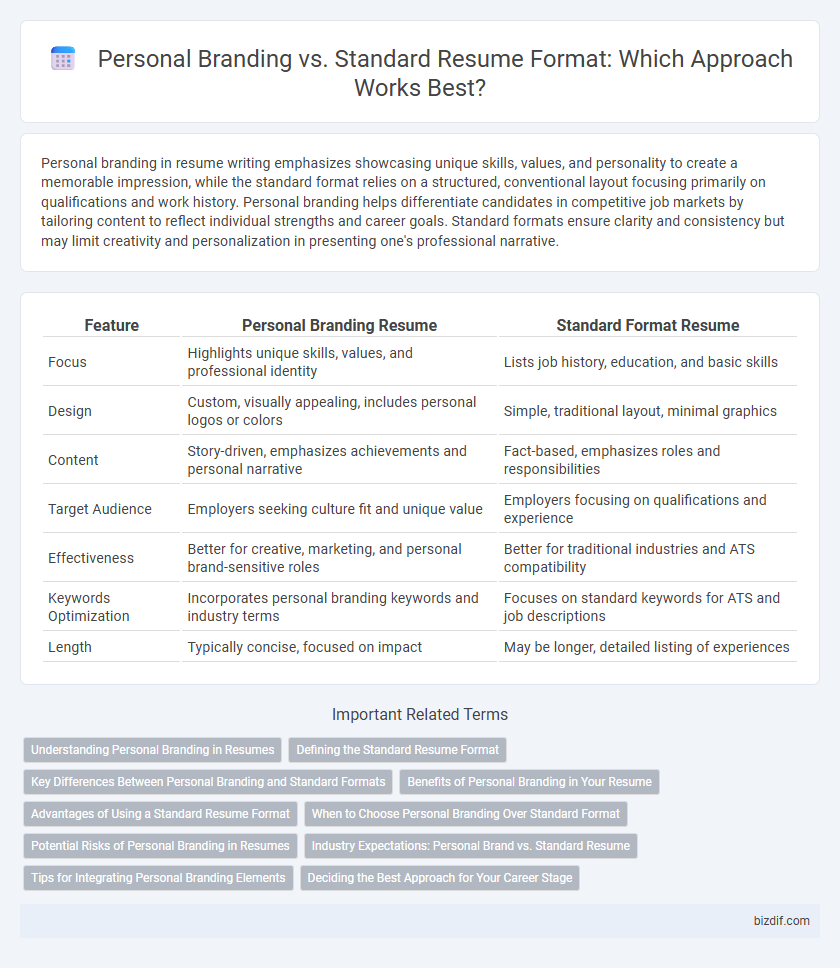Personal branding in resume writing emphasizes showcasing unique skills, values, and personality to create a memorable impression, while the standard format relies on a structured, conventional layout focusing primarily on qualifications and work history. Personal branding helps differentiate candidates in competitive job markets by tailoring content to reflect individual strengths and career goals. Standard formats ensure clarity and consistency but may limit creativity and personalization in presenting one's professional narrative.
Table of Comparison
| Feature | Personal Branding Resume | Standard Format Resume |
|---|---|---|
| Focus | Highlights unique skills, values, and professional identity | Lists job history, education, and basic skills |
| Design | Custom, visually appealing, includes personal logos or colors | Simple, traditional layout, minimal graphics |
| Content | Story-driven, emphasizes achievements and personal narrative | Fact-based, emphasizes roles and responsibilities |
| Target Audience | Employers seeking culture fit and unique value | Employers focusing on qualifications and experience |
| Effectiveness | Better for creative, marketing, and personal brand-sensitive roles | Better for traditional industries and ATS compatibility |
| Keywords Optimization | Incorporates personal branding keywords and industry terms | Focuses on standard keywords for ATS and job descriptions |
| Length | Typically concise, focused on impact | May be longer, detailed listing of experiences |
Understanding Personal Branding in Resumes
Personal branding in resumes emphasizes showcasing unique skills, values, and professional identity to differentiate candidates from others using the standard format. This approach integrates a consistent narrative, targeted keywords, and personalized design elements to highlight an individual's strengths and career goals. Understanding personal branding helps job seekers create resumes that resonate with employers and align with specific industry demands, enhancing their chances of securing interviews.
Defining the Standard Resume Format
The standard resume format typically includes predefined sections such as contact information, objective or summary, work experience, education, and skills, organized in reverse chronological order to highlight the most recent achievements. This format emphasizes clarity, consistency, and professionalism, making it universally accepted by recruiters and applicant tracking systems (ATS). While personal branding incorporates unique elements like personalized design and storytelling, the standard resume format remains essential for ensuring compatibility and ease of review in traditional hiring processes.
Key Differences Between Personal Branding and Standard Formats
Personal branding resumes emphasize unique value propositions, showcasing individual skills and achievements tailored to specific roles, while standard formats prioritize uniformity and traditional sections like education and experience. Personal branding uses creative layouts, personalized summaries, and targeted keywords to attract recruiters in competitive markets, whereas standard resumes often follow chronological or functional templates. The key difference lies in personalization and strategic storytelling versus standardized structure and broad applicability.
Benefits of Personal Branding in Your Resume
Personal branding in a resume highlights unique skills, achievements, and professional identity, making candidates stand out to employers. It fosters a memorable impression by showcasing personality and core values aligned with the job role. Personal branding increases visibility in applicant tracking systems and enhances networking opportunities, boosting chances of securing interviews.
Advantages of Using a Standard Resume Format
Using a standard resume format enhances readability and ensures key information is easily accessible to recruiters and applicant tracking systems (ATS), improving the chances of passing initial screenings. This format provides a consistent, professional layout that highlights work experience, skills, and education effectively, which is preferred by hiring managers for quick evaluation. Standard resumes also simplify customization for different job applications while maintaining a clear structure that appeals to diverse industries.
When to Choose Personal Branding Over Standard Format
Personal branding resumes excel when targeting creative industries, entrepreneurship, or positions requiring strong individuality and unique value propositions. Choose personal branding over the standard format to highlight personal stories, distinctive skills, and tailored achievements that differentiate candidates from the competition. This approach is ideal for professionals aiming to establish a memorable identity in saturated job markets or roles emphasizing innovation and personality.
Potential Risks of Personal Branding in Resumes
Personal branding in resumes can dilute objectivity, leading recruiters to perceive candidates as overly self-promotional or lacking substance. Unlike standard formats, which emphasize clear, uniform presentation of skills and experience, personal branding risks overshadowing qualifications with flashy design or subjective narratives. This approach may alienate applicant tracking systems (ATS) and reduce compatibility with traditional hiring processes, potentially limiting job opportunities.
Industry Expectations: Personal Brand vs. Standard Resume
Industry expectations prioritize tailored personal branding in resumes to showcase unique skills and cultural fit, contrasting with the traditional standard format that emphasizes uniformity and generic qualification listing. Personal branding incorporates strategic use of keywords, professional summaries, and visual elements aligned with industry-specific criteria, enhancing applicant visibility in Applicant Tracking Systems (ATS). Employers in dynamic sectors prefer resumes that reflect individual value propositions and adaptability rather than rigid, template-driven documents.
Tips for Integrating Personal Branding Elements
Incorporating personal branding elements into a resume involves highlighting unique skills, professional achievements, and a consistent visual style that reflects your career identity. Use a custom header with your name and logo, a branded summary statement emphasizing your core competencies, and tailor the language to align with your personal value proposition. Maintain clarity and professionalism by integrating these elements subtly within the standard resume format to enhance readability and impact.
Deciding the Best Approach for Your Career Stage
Assessing personal branding versus a standard resume format depends on your career stage: early professionals benefit from clear, concise standard layouts showcasing skills and education, while experienced candidates gain from personal branding that highlights unique value and industry presence. Tailoring your resume style to reflect your career achievements ensures greater impact with potential employers and recruiters. Emphasizing relevant keywords and accomplishments aligns your resume with job market expectations and enhances visibility.
Personal branding vs Standard format Infographic

 bizdif.com
bizdif.com